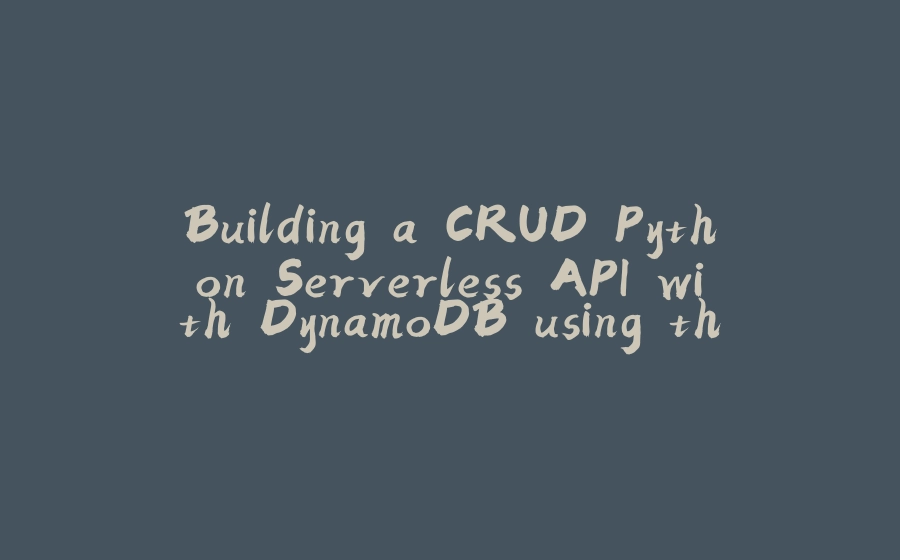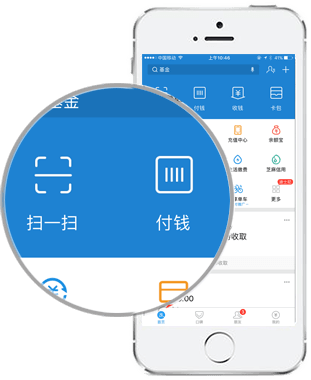Hi,My name is Noble Mutuwa Mulaudzi, AWS DevOps Engineer and Linux enthusiast.
In this tutorial, we’ll learn how to build a serverless API using Python and DynamoDB, leveraging the power of the Serverless Framework. The API will provide Create, Read, Update, and Delete (CRUD) operations for managing items. We’ll also demonstrate how to test the API using Postman.
_
Architecture diagram
_
- Source code: (https://github.com/Mutuwa99/python-crud-api)
Prerequisites
To follow along with this tutorial, you’ll need the following:
-
Python 3.x installed on your machine.
-
Node.js and npm installed for installing the Serverless Framework.
-
An AWS account with appropriate permissions to create resources like Lambda
Setting up the Project
1.Install the Serverless Framework by running the following command:
npm install -g serverlessnpm install -g serverlessnpm install -g serverless
Enter fullscreen mode Exit fullscreen mode
2.Create a new directory for your project and navigate into it.
mkdir python_rest_apicd python_rest_apimkdir python_rest_api cd python_rest_apimkdir python_rest_api cd python_rest_api
Enter fullscreen mode Exit fullscreen mode
3.Initialize a new Serverless service using the following command:
serverless create --template aws-python3 --name python_rest_apiserverless create --template aws-python3 --name python_rest_apiserverless create --template aws-python3 --name python_rest_api
Enter fullscreen mode Exit fullscreen mode
4.Install the required Python packages by running:
pip install boto3pip install boto3pip install boto3
Enter fullscreen mode Exit fullscreen mode
- Create separate Python files for each CRUD operation inside the project directory:
-
create.py
-
delete.py
-
update.py
-
read_one.py
-
read_all.py
Configuring DynamoDB
1.Open the serverless.yml file and update it with the following configuration:
service: my-serverless-apiprovider:name: awsruntime: python3.8functions:create:handler: create.createevents:- http:path: itemsmethod: postreadAll:handler: read_all.read_allevents:- http:path: itemsmethod: getreadOne:handler: read_one.read_oneevents:- http:path: items/{id}method: getupdate:handler: update.updateevents:- http:path: items/{id}method: putdelete:handler: delete.deleteevents:- http:path: items/{id}method: deleteresources:Resources:ItemsTable:Type: AWS::DynamoDB::TableProperties:TableName: ItemsAttributeDefinitions:- AttributeName: idAttributeType: SKeySchema:- AttributeName: idKeyType: HASHProvisionedThroughput:ReadCapacityUnits: 1WriteCapacityUnits: 1service: my-serverless-api provider: name: aws runtime: python3.8 functions: create: handler: create.create events: - http: path: items method: post readAll: handler: read_all.read_all events: - http: path: items method: get readOne: handler: read_one.read_one events: - http: path: items/{id} method: get update: handler: update.update events: - http: path: items/{id} method: put delete: handler: delete.delete events: - http: path: items/{id} method: delete resources: Resources: ItemsTable: Type: AWS::DynamoDB::Table Properties: TableName: Items AttributeDefinitions: - AttributeName: id AttributeType: S KeySchema: - AttributeName: id KeyType: HASH ProvisionedThroughput: ReadCapacityUnits: 1 WriteCapacityUnits: 1service: my-serverless-api provider: name: aws runtime: python3.8 functions: create: handler: create.create events: - http: path: items method: post readAll: handler: read_all.read_all events: - http: path: items method: get readOne: handler: read_one.read_one events: - http: path: items/{id} method: get update: handler: update.update events: - http: path: items/{id} method: put delete: handler: delete.delete events: - http: path: items/{id} method: delete resources: Resources: ItemsTable: Type: AWS::DynamoDB::Table Properties: TableName: Items AttributeDefinitions: - AttributeName: id AttributeType: S KeySchema: - AttributeName: id KeyType: HASH ProvisionedThroughput: ReadCapacityUnits: 1 WriteCapacityUnits: 1
Enter fullscreen mode Exit fullscreen mode
Implementing the CRUD Functions
2.Open the create.py file and update it with the following code:
import jsonimport boto3from botocore.exceptions import ClientErrordynamodb = boto3.resource('dynamodb')table = dynamodb.Table('Items')def create(event, context):data = json.loads(event['body'])item_id = data['id']item_name = data['name']item_price = data['price']try:table.put_item(Item={'id': item_id,'name': item_name,'price': item_price})response = {'statusCode': 200,'body': json.dumps({'message': 'Item created successfully'})}except ClientError as e:response = {'statusCode': 500,'body': json.dumps({'error': str(e)})}return responseimport json import boto3 from botocore.exceptions import ClientError dynamodb = boto3.resource('dynamodb') table = dynamodb.Table('Items') def create(event, context): data = json.loads(event['body']) item_id = data['id'] item_name = data['name'] item_price = data['price'] try: table.put_item( Item={ 'id': item_id, 'name': item_name, 'price': item_price } ) response = { 'statusCode': 200, 'body': json.dumps({'message': 'Item created successfully'}) } except ClientError as e: response = { 'statusCode': 500, 'body': json.dumps({'error': str(e)}) } return responseimport json import boto3 from botocore.exceptions import ClientError dynamodb = boto3.resource('dynamodb') table = dynamodb.Table('Items') def create(event, context): data = json.loads(event['body']) item_id = data['id'] item_name = data['name'] item_price = data['price'] try: table.put_item( Item={ 'id': item_id, 'name': item_name, 'price': item_price } ) response = { 'statusCode': 200, 'body': json.dumps({'message': 'Item created successfully'}) } except ClientError as e: response = { 'statusCode': 500, 'body': json.dumps({'error': str(e)}) } return response
Enter fullscreen mode Exit fullscreen mode
3.Open the delete.py file and update it with the following code:
import jsonimport boto3from botocore.exceptions import ClientErrordynamodb = boto3.resource('dynamodb')table = dynamodb.Table('Items')def delete(event, context):item_id = event['pathParameters']['id']try:table.delete_item(Key={'id': item_id})response = {'statusCode': 200,'body': json.dumps({'message': 'Item deleted successfully'})}except ClientError as e:response = {'statusCode': 500,'body': json.dumps({'error': str(e)})}return responseimport json import boto3 from botocore.exceptions import ClientError dynamodb = boto3.resource('dynamodb') table = dynamodb.Table('Items') def delete(event, context): item_id = event['pathParameters']['id'] try: table.delete_item(Key={'id': item_id}) response = { 'statusCode': 200, 'body': json.dumps({'message': 'Item deleted successfully'}) } except ClientError as e: response = { 'statusCode': 500, 'body': json.dumps({'error': str(e)}) } return responseimport json import boto3 from botocore.exceptions import ClientError dynamodb = boto3.resource('dynamodb') table = dynamodb.Table('Items') def delete(event, context): item_id = event['pathParameters']['id'] try: table.delete_item(Key={'id': item_id}) response = { 'statusCode': 200, 'body': json.dumps({'message': 'Item deleted successfully'}) } except ClientError as e: response = { 'statusCode': 500, 'body': json.dumps({'error': str(e)}) } return response
Enter fullscreen mode Exit fullscreen mode
4.Open the update.py file and update it with the following code:
import jsonimport boto3from botocore.exceptions import ClientErrordynamodb = boto3.resource('dynamodb')table = dynamodb.Table('Items')def update(event, context):item_id = event['pathParameters']['id']data = json.loads(event['body'])item_name = data['name']item_price = data['price']try:response = table.update_item(Key={'id': item_id},UpdateExpression='set #name = :n, #price = :p',ExpressionAttributeNames={'#name': 'name', '#price': 'price'},ExpressionAttributeValues={':n': item_name, ':p': item_price},ReturnValues='UPDATED_NEW')updated_item = response['Attributes']response = {'statusCode': 200,'body': json.dumps(updated_item)}except ClientError as e:response = {'statusCode': 500,'body': json.dumps({'error': str(e)})}return responseimport json import boto3 from botocore.exceptions import ClientError dynamodb = boto3.resource('dynamodb') table = dynamodb.Table('Items') def update(event, context): item_id = event['pathParameters']['id'] data = json.loads(event['body']) item_name = data['name'] item_price = data['price'] try: response = table.update_item( Key={'id': item_id}, UpdateExpression='set #name = :n, #price = :p', ExpressionAttributeNames={'#name': 'name', '#price': 'price'}, ExpressionAttributeValues={':n': item_name, ':p': item_price}, ReturnValues='UPDATED_NEW' ) updated_item = response['Attributes'] response = { 'statusCode': 200, 'body': json.dumps(updated_item) } except ClientError as e: response = { 'statusCode': 500, 'body': json.dumps({'error': str(e)}) } return responseimport json import boto3 from botocore.exceptions import ClientError dynamodb = boto3.resource('dynamodb') table = dynamodb.Table('Items') def update(event, context): item_id = event['pathParameters']['id'] data = json.loads(event['body']) item_name = data['name'] item_price = data['price'] try: response = table.update_item( Key={'id': item_id}, UpdateExpression='set #name = :n, #price = :p', ExpressionAttributeNames={'#name': 'name', '#price': 'price'}, ExpressionAttributeValues={':n': item_name, ':p': item_price}, ReturnValues='UPDATED_NEW' ) updated_item = response['Attributes'] response = { 'statusCode': 200, 'body': json.dumps(updated_item) } except ClientError as e: response = { 'statusCode': 500, 'body': json.dumps({'error': str(e)}) } return response
Enter fullscreen mode Exit fullscreen mode
5.Open the read_one.py file and update it with the following code:
import jsonimport boto3from botocore.exceptions import ClientErrordynamodb = boto3.resource('dynamodb')table = dynamodb.Table('Items')def read_one(event, context):item_id = event['pathParameters']['id']try:response = table.get_item(Key={'id': item_id})item = response.get('Item')if item:response = {'statusCode': 200,'body': json.dumps(item)}else:response = {'statusCode': 404,'body': json.dumps({'error': 'Item not found'})}except ClientError as e:response = {'statusCode': 500,'body': json.dumps({'error': str(e)})}return responseimport json import boto3 from botocore.exceptions import ClientError dynamodb = boto3.resource('dynamodb') table = dynamodb.Table('Items') def read_one(event, context): item_id = event['pathParameters']['id'] try: response = table.get_item(Key={'id': item_id}) item = response.get('Item') if item: response = { 'statusCode': 200, 'body': json.dumps(item) } else: response = { 'statusCode': 404, 'body': json.dumps({'error': 'Item not found'}) } except ClientError as e: response = { 'statusCode': 500, 'body': json.dumps({'error': str(e)}) } return responseimport json import boto3 from botocore.exceptions import ClientError dynamodb = boto3.resource('dynamodb') table = dynamodb.Table('Items') def read_one(event, context): item_id = event['pathParameters']['id'] try: response = table.get_item(Key={'id': item_id}) item = response.get('Item') if item: response = { 'statusCode': 200, 'body': json.dumps(item) } else: response = { 'statusCode': 404, 'body': json.dumps({'error': 'Item not found'}) } except ClientError as e: response = { 'statusCode': 500, 'body': json.dumps({'error': str(e)}) } return response
Enter fullscreen mode Exit fullscreen mode
6.Open the read_all.py file and update it with the following code:
import jsonimport boto3from botocore.exceptions import ClientErrordynamodb = boto3.resource('dynamodb')table = dynamodb.Table('Items')def read_all(event, context):try:response = table.scan()items = response['Items']response = {'statusCode': 200,'body': json.dumps(items)}except ClientError as e:response = {'statusCode': 500,'body': json.dumps({'error': str(e)})}return responseimport json import boto3 from botocore.exceptions import ClientError dynamodb = boto3.resource('dynamodb') table = dynamodb.Table('Items') def read_all(event, context): try: response = table.scan() items = response['Items'] response = { 'statusCode': 200, 'body': json.dumps(items) } except ClientError as e: response = { 'statusCode': 500, 'body': json.dumps({'error': str(e)}) } return responseimport json import boto3 from botocore.exceptions import ClientError dynamodb = boto3.resource('dynamodb') table = dynamodb.Table('Items') def read_all(event, context): try: response = table.scan() items = response['Items'] response = { 'statusCode': 200, 'body': json.dumps(items) } except ClientError as e: response = { 'statusCode': 500, 'body': json.dumps({'error': str(e)}) } return response
Enter fullscreen mode Exit fullscreen mode
Deploy the Serverless API using the following command:
serverless deployserverless deployserverless deploy
Enter fullscreen mode Exit fullscreen mode
Testing the API using Postman
-
Open Postman and create a new request
-
Set the request URL to the appropriate endpoint for each CRUD operation that you got when you did serverless deloy :
- Replace with the actual API endpoint you noted down earlier.
3.Set the request body for the create and update operations. For example:
{"id": "1","name": "Noble's Bill","price": "R10 000"}{ "id": "1", "name": "Noble's Bill", "price": "R10 000" }{ "id": "1", "name": "Noble's Bill", "price": "R10 000" }
Enter fullscreen mode Exit fullscreen mode
4.Send the request and observe the responses.
POST Request:
Get Request:
-
Congratulations! You have successfully built a CRUD Python serverless API with DynamoDB using the Serverless Framework. You’ve also tested the API using Postman.
-
Feel free to explore and expand upon this foundation to build more complex serverless APIs to suit your specific requirements.
-
That concludes the tutorial. We’ve covered how to create a CRUD Python serverless API with DynamoDB using the Serverless Framework and testing through postman
Article by Noble Mutuwa Mulaudzi
原文链接:Building a CRUD Python Serverless API with DynamoDB using the Serverless Framework.













暂无评论内容